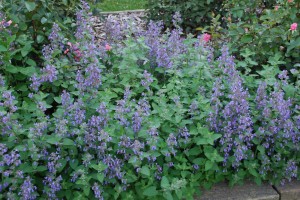Catmint (Nepeta spp.) is a favorite of cats who like to roll around in it, sometimes to the detriment of the plant(s) (USDA hardiness zones 3-8). There are several species of catmint. Most popular are the gray-green leafed N. x faassenii and hairy gray heart-shaped leafed N. racemosa. Depending on the cultivar selected, this versatile perennial grows 1 1/2 to 3 feet high and varying widths.
Catmint grows in average well-drained soil and in full to partial sun (6 hours minimum); shade-grown plants are floppy and flower poorly. One-year established catmints exhibit exceptional heat, drought, and humidity tolerance. Established plants prefer dry (not sopping wet), and low fertility soil.
Catmints bloom from late spring to early fall. Purple, blue, pink or white flowers (depending on species and cultivar) bloom over 3-4 weeks. Prune back plants by two-thirds in late June or July to stimulate August-September re-bloom. Catmints need to be divided every 3 – 4 years in early spring. Cutback old foliage in late winter rather than in the fall.
Plants are highly deer and rabbit resistant. Hummingbirds and numerous nectar gathering bees and butterflies visit the aromatic flowers. Foliage is seaside/salt resistant. The aromatic blooms make good cutflowers and are utilized in floral designs.
Catmint grows in flower gardens, rock and herb gardens, and in containers. Low-growing cultivars work as great edging plants in front borders and as a perennial ground cover.
Popular cultivars:
N. racemosa ‘Walker’s Low’ grows 24 to 30 inches high with blue violet sterile flowers and aromatic grey green foliage (2007 Perennial Plant Association Plant of the Year).
N. x faassenii ‘Six Hills Giant’ is a taller growing catmint (30 to 36 inches high) with dark green leaves and deep violet-purple blooms.
N. x faassenii ‘Blue Wonder’ is a compact grower (12 to 15 inch tall plant and greater spread), dark green leaves, and dark blue blooms. ‘White Wonder’ has white blooms.


 Posted in
Posted in 
